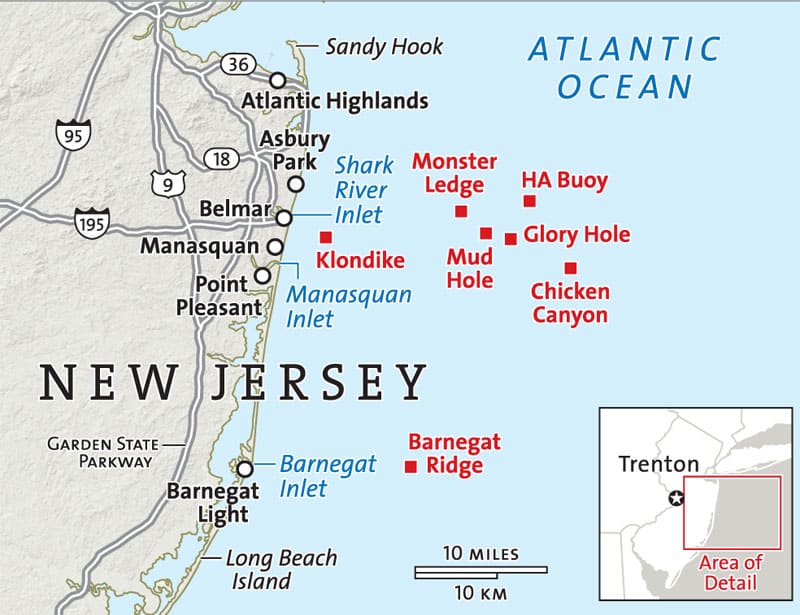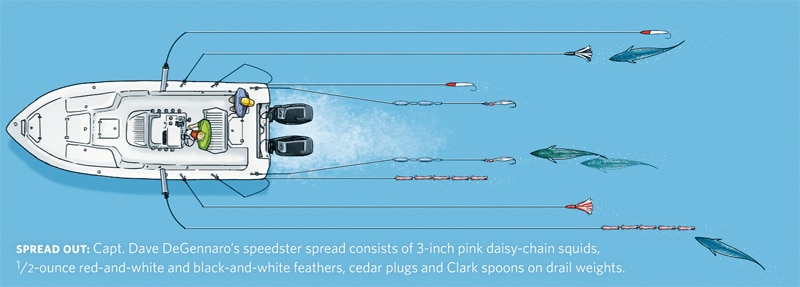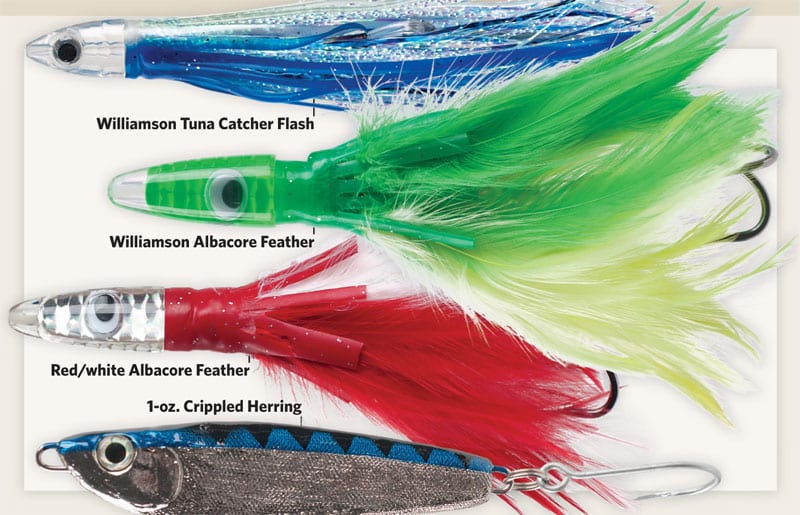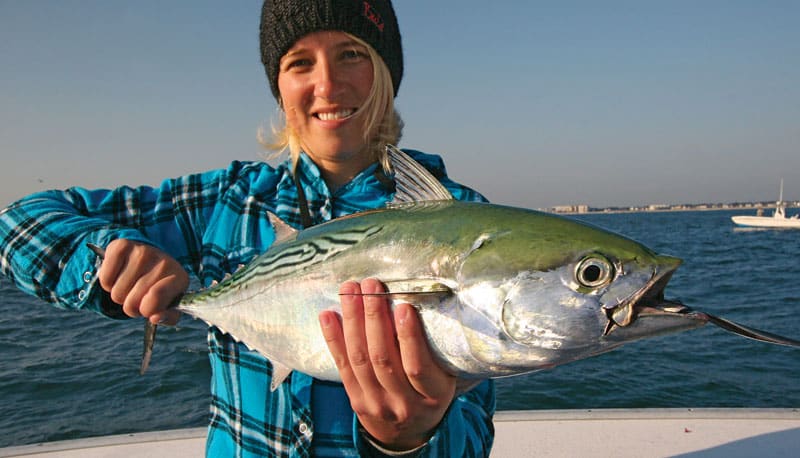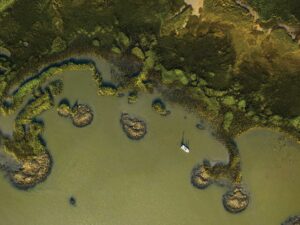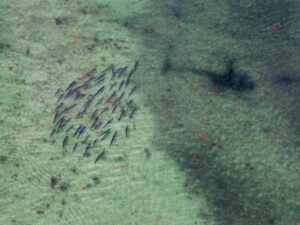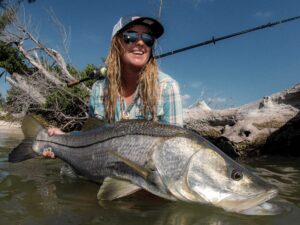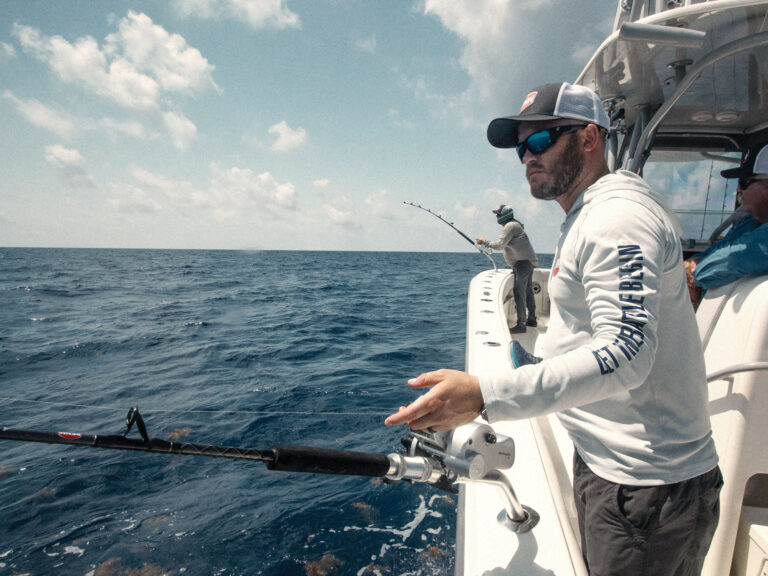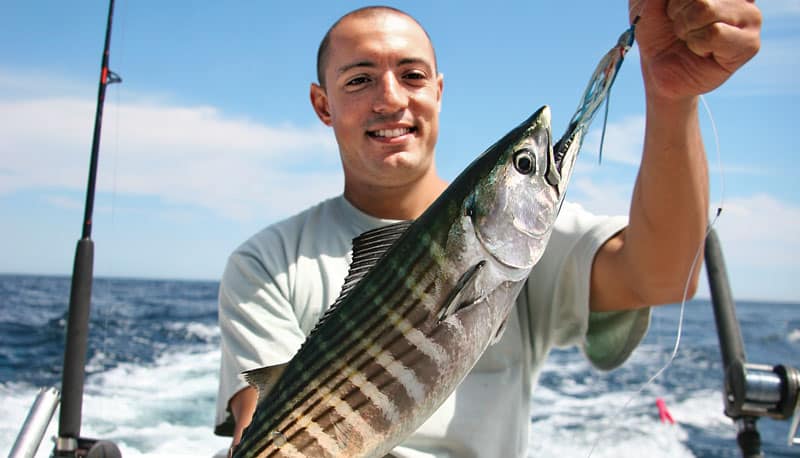
Fast and Furious
Everything moves fast in New Jersey, even more so during the boisterous summer tourist season, when the head-spinning pace of zooming Parkway traffic and the quick-serve barkers pushing slices of boardwalk pizza keep you on the go. Fast is key, and the summer maelstrom also ushers in speedy pelagic characters in the form of lightning-quick dynamos, as false albacore (little tunny) and Atlantic bonito invade the nearshore waters. The one-two punch of summertime speed demons makes for some serious drag-peeling fun times. Here’s the lowdown on how to fine-tune your playbook to catch up with the speed freaks.
Speed Traps
False albacore and Atlantic bonito are notorious for living the magician’s mantra “Now you see me; now you don’t.” When schools of albies or bones are moving, it can be a daunting task to keep your eye on them and stay in pursuit with the school’s rapid 10-knot pace, but you can bring the game to you. Capt. Gene Quigley of Shore Catch Guide Service usually starts his albie hunt with a chunk slick. “We’ll find some higher pimples and hills inside the 20-fathom curve where conditions of upwelling are prevalent,” says Quigley. “Then we’ll dish out fresh spearing and peanut bunker little by little to get the scent in the water and bring them to us.” Another trick Quigley uses to bring the albies up from below is to get their attention topside. “I’ll throw out a weightless 7-inch Hogy, Carolina-rigged, and rip it across the surface so it slaps and splashes. The albacore and bonito come up immediately to investigate, and when they get close enough to the boat, we bait-and-switch them with a pitch-baited live peanut bunker or fresh spearing for a hookup.”
Capt. Dave DeGennaro of Hi Flier relies on the troll to find the speedy schools. “I’ll troll an eight-rod spread between 6 and 7 knots with a spread of daisy chains, cedar plugs, mini squids and feathers. I’m looking for erratic bottom of hills, ridges and lumps, but will also keep an eye out for tuna chick birds, cobalt-blue water in the 65- to 75-degree range, and the presence of sand eels or flying fish.” The last three weeks in July are especially prime times for finding bones, while albies really begin to push in during August and September.
Cast and Blast
Once albies mark on the fish finder, Quigley has the rods ready to go with ½-ounce Deadly Dick metals or ¼- to ½-ounce red-and-white bucktails tipped with a fresh spearing. “If the fish are breaking the surface, I’ll launch the metal or bucktail and work it back to the boat. Many times, the trick is to reel as fast as you can, but pay attention to how the albies are feeding. If they are aggressively inhaling the chunk baits, they’ll chase down a fast-retrieved metal. If they are thumbing their nose at chunks, then you want to work a bucktail in a quirky, erratic manner to get them to strike.”
DeGennaro implements a different strategy if he sees the bonito and albacore feeding aggressively when on the troll. “If they are flashing and busting the surface on the lures but not hitting hot, I’ll reel in the lines and then send out fresh spearing on 20-pound outfits and skip them on the surface between the second and third wake with the boat at a 6-knot pace. It triggers something ferocious in both bonito and albies. They go nuts over the sight of the spearing flashing and skipping in and out of the water.” DeGennaro hooks the spearing with a 1/0 Gamakatsu live-bait hook through the lips and out the rigid part of the skull for skipping.
Slick Trick
Nothing gets the adrenaline pumping like witnessing quick, silvery torpedoes streaking five feet below the water’s surface, zipping off drag. Pitching baits to the speed demons can be the most fun and rewarding on light tackle. Anchoring on the upside of a ledge, DeGennaro fastidiously dishes out a handful of fresh spearing uptide every time the previous handful drifts out of sight: “I always have one pint to four gallons of fresh spearing on hand, freshly seine-netted.” DeGennaro’s free-line rig consists of running line of 12-pound mono, a 50-pound barrel swivel, a 30-inch section of 20-pound fluorocarbon leader and a No. 1 Gamakatsu live-bait hook on a weightless flat line. “The visual strikes are absolutely wild, and neither bones nor albies are shy about feeding in a slick environment, many times gobbling up slick baits inches from the stern,” says DeGennaro.
When the fish are fired up in a slick, they are hot to bite and will readily strike lures. One trick I pulled from a local albie slayer was a snap-twitch technique: A 4-inch pink or white Fin-S Fish rigged on a ½-ounce lead-head was cast into the general vicinity of the school and erratically snapped as if you were furiously trying to unhook your lure out of a snag with quick, jerking pulls of the rod so that the rubber bait would twitch with a frantic, confused motion. It seemed to make the albies go bananas.
Lightning Strikes Twice
Any day out fishing Jersey’s nearshore in summertime can mean a full day’s fight club, with drags screaming and lines zipping through the water as the twosome of false albie and bonito show together along the Jersey coast. Just make sure you’ve got the speed you need to be up for the challenge to chase them down!
TRIP PLANNER
Rods: 6-foot Tsunami TSTBC-J601XH, 7-foot St. Croix Legend-series rods.
Reels: Avet MXL or equivalent light conventional reels spooled with 20-pound monofilament, Shimano Sustain 4000-size spinning reel.
Lines: 12- to 20-pound running line with 20-pound fluorocarbon leader.
Lures: 1/4- to 1-ounce red-and-white or chartreuse-and-white bucktails, 1- to 3-ounce Deadly Dicks, Sting-O jigs, A17 Ava jigs, trolled feathers and small squids, No. 0 or No. 1 Clark spoons.
What: False albacore and bonito, with bluefin tuna, dolphin, Spanish mackerel and skipjack tuna also in the mix.
When: June through September.
Where: New Jersey’s inshore to midshore grounds.
Who:
Capt. Dave DeGennaro
Hi Flier Sport Fishing
732-330-5674
www.hiflier.com
Capt. Gene Quigley
Shore Catch Guide Service
www.shorecatch.com

Fast and Furious
